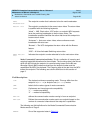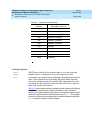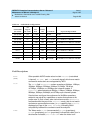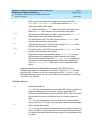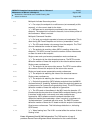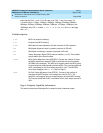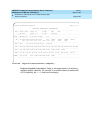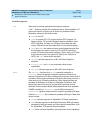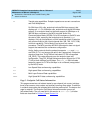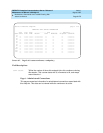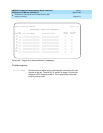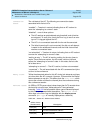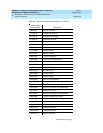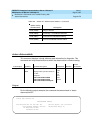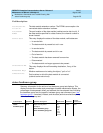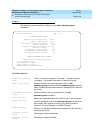
DEFINITY Enterprise Communications Server Release 6
Maintenance for R6vs/si
555-230-127
Issue 1
August 1997
Maintenance Commands and Trouble-Clearing Aids
Page 8-269status conference
8
Page 5 - Endpoint Call Status Information
This page summarizes call-related status for per-channel join counts, join/drop
times, drop reasons, drop codes, and auxiliary bonding drop codes. In addition,
it contains drop codes and software fields from the previous call. The data on the
page is retained. The Endpoint Call Status Information section groups all
call-related fields. The only new field in this section is Join Count; all other
fields are described in Screen 8-3
and Screen 8-4.
XR
Transfer rate capabilities. Endpoint speeds over current connections
and Px64 Multiplexes.
For 384 kbps (H0) calls, endpoints indicate 384 kbps support, that
displays as 384. On 336 kbps calls, endpoints must signal 384 kbps
support. If an endpoint does not indicate support for 384 kbps on a
384/336 kbps conference, the MCU provides Audio Only
Communications Mode (ACOM). For a 2B conference, the MCU sets
the rate to 2x64, expecting the endpoints to do likewise (64x2
displays; if this is not displayed, no 64x2 capability exists). Endpoints
may remove 2x64 (or the current channel rate: 384, 768, 1472, 1536)
from their capability. This is Mode 0 forcing and is a normal
procedure. The MCU provides AOCM if the endpoint does not signal
support that matches the conference configuration.
AUD
Audio. Audio protocols that the endpoint supports. 711m and 711a
are PCM (G.711) and support Mu and A-law, respectively. Endpoints
require at least one. The g728 field indicates if G.728 is supported
(LB_CELP). This value depends upon the endpoint type and
configuration. The g722_48 field indicates endpoint support for G.722
(7 kHz) at both 48 kbps and 56 kbps. The g722_64 field indicates
endpoint support for G.722 at 64 kbps in an unframed (unsupported
by the MCU) mode.
LSD
Low Speed Data conferencing capabilities.
HSD
High speed Data conferencing capabilities.
MLP
Multi Layer Protocol Data capabilities.
HMLP High Speed MLP data conferencing capabilities.



